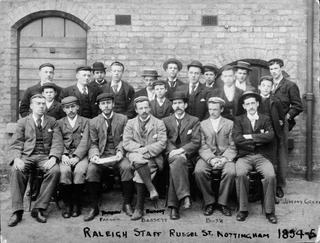
Biggs, Theodore James 1806 - 1906
- Nationality:
- English; British
Biggs, TJ (fl 1892-1929), Bicycle and Motorcycle designer
Theodore James Biggs was born in Frome, Somerset, in June 1869. He attended Taunton College 1882-1884 and in 1885 he took up an apprenticeship at Messrs E. S. Hindley and Sons iron foundry in Bourton, Dorset. It is not known when Biggs first began cycling, but he was an active cyclist during his apprenticeship, cycling to Weymouth, Sheffield and London, winning prizes in local bike races at Melksham and being elected captain of the local Bike Club in 1890.
In 1891 he left Bourton, applying for a patent for an invention to improve ‘the arrangements for the fixing of the saddles’ to bicycles and other similar machines, perhaps with the intention of establishing his own cycle business in the Market Place, Frome. It was in 1891 however that Biggs met Sam Lovelace, a blacksmith, and in 1892 Biggs and Lovelace were given charge of Poole Foundry in Dorset with the aim of producing the ‘Lovelace’ bicycle. Biggs was put in charge of design but no bicycles were ever made and in September 1892 Biggs took up a position with the Raleigh Cycle Company in Nottingham, being the first draughtsman appointed at the company following its rebranding under the management of Frank Bowden. Among his designs there was the bicycle used by A. A. Zimmerman, winner of the first World Championship for cycling in 1893. He left Raleigh briefly in 1893 to begin his own cycle business but returned in 1894 and remained until 1897, helping to design the range of open and cross framed single and tandem bicycles for which Raleigh became famous.
Biggs left Raleigh in 1897 to work for A. C. Hills in Birmingham, where he oversaw production at the factory and designed the popular ‘Ascot’ bicycle. It was during this time that Biggs also worked on The Cycle Referee, a US owned cycling periodical.
Around 1899, Biggs’ interest turned to motoring and in this year he left A. C. Hills and returned to Frome, purchasing a de Dion Bouton motor tricycle. The following year he went into partnership with Frederick Eastmead, a lift manufacturer from London, to design the Eastmead and Biggs motorcar. The partnership manufactured 3 cars between 1900 and 1904 but they lacked the funds to produce and market them in significant numbers and the business was sold in 1904.
Biggs returned to Raleigh 1904-1905, this time to design and construct a prototype Raleigh motorcar which was never put into full production due to lack of capital. In 1905 Webb joined Humbers Works at Beeston, and in 1906 he married May Clunies Ross before moving with his wife to Humbers’ Coventry works in 1908. There, he designed the TT [Tourist Trophy] motorcar racers of 1906-7 and 1908, and later redesigned the Humber Cordner 3 speed gear for their Road Racer bicycle.
In 1909 he left Humber to take a position as Chief Designer for Arrol Johnson of Paisley where his motorcar designs included Grand Prix racers in 1910-11 and 1912 and the first engine with an aluminium crankcase and water jacket. Between 1912 and 1914 he returned to Humber as Chief Engineer, designing the 10, 11 and 14 horsepower Humber cars and the 11 horsepower Brooklands racing car. There followed a period with F. E. Baker Ltd as Chief Designer 1914-1922 where he designed the Beardmore Precision Motorcycle, before he joined Aster Engineering in 1922. He remained with the company through its merger with Arrol-Johnston Ltd in 1927 when it became Arrol-Aster. In 1939, at the age of 70, he joined the Austin Motor Company in Longbridge. Between 1948 and 1954 he also collaborated with the Harden Tool and Gauge Company to design and patent the Harden-Biggs Conversion Axle.
Theodore James Biggs died in Birmingham in June 1959 at the age of 89.